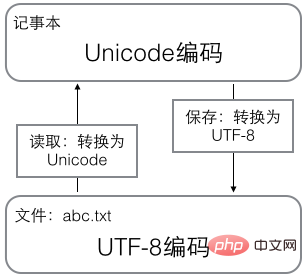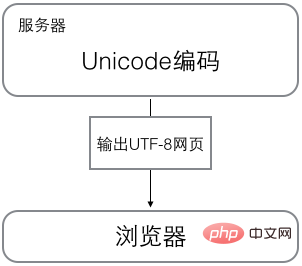What is the difference between unicode and ascii
Difference: 1. ASCII encoding is 1 byte, while Unicode encoding is usually 2 bytes. 2. ASCII is a single-byte encoding and cannot be used to represent Chinese; Unicode can represent all languages. 3. Unicode encoding requires twice as much storage space as ASCII encoding.

The operating environment of this tutorial: Windows 7 system, Dell G3 computer.
ASCII encoding
- ASCII code uses specified 7-bit or 8-bit binary number combinations to represent 128 or 256 possible character. Standard ASCII code, also called basic ASCII code, uses 7 binary digits (the remaining 1 binary digit is 0) to represent all uppercase and lowercase letters, numbers 0 to 9, punctuation marks, and special controls used in American English. character. The last bit is used for parity checking.
- Problem: ASCII is a single-byte encoding and cannot be used to represent Chinese (Chinese encoding requires at least 2 bytes). Therefore, China has formulated the GB2312 encoding to encode Chinese. But there are many different languages in the world, so a unified encoding is needed.
Unicode
- Unicode unifies all languages into one set of codes, so there will be no more garbled characters Problem.
- Unicode most commonly uses two bytes to represent a character (if you want to use very remote characters, you need 4 bytes). Modern operating systems and most programming languages support Unicode directly.
The difference between Unicode and ASCII
- ASCII encoding is 1 byte, while Unicode encoding is usually 2 byte.
The ASCII encoding of the letter A is 65 in decimal and 01000001 in binary; in Unicode, you only need to add 0 in front, which is: 00000000 01000001. - New problem: If unified into Unicode encoding, the problem of garbled characters will disappear. However, if the text you write is basically all in English, Unicode encoding requires twice as much storage space as ASCII encoding, which is very uneconomical in terms of storage and transmission.
UTF8
- So, in the spirit of conservation, there is another idea to convert Unicode encoding into "variable long encoding" UTF-8 encoding.
- UTF-8 encoding encodes a Unicode character into 1-6 bytes according to different number sizes. Commonly used English letters are encoded into 1 byte. Chinese characters are usually 3 bytes, and only a few Uncommon characters will be encoded into 4-6 bytes. If the text you want to transmit contains a lot of English characters, using UTF-8 encoding can save space.
| Characters | ASCII | Unicode | UTF-8 |
|---|---|---|---|
| A | 01000001 | 00000000 01000001 | 01000001 |
| 中文 | x | 01001110 00101101 | 01001110 00101101 |
- ##It can also be found from the above table that UTF-8 encoding has an additional The advantage is that ASCII encoding can actually be regarded as part of UTF-8 encoding. Therefore, a large number of historical legacy software that only supports ASCII encoding can continue to work under UTF-8 encoding.
- In computer memory, Unicode encoding is uniformly used. When it needs to be saved to the hard disk or needs to be transferred, it is converted. Encoded to UTF-8.
- When editing with Notepad, the UTF-8 characters read from the file are converted into Unicode characters and stored in the memory. After the editing is completed, Unicode is converted into UTF-8 when saving. To the file:

- When browsing the web, the server will convert the dynamically generated Unicode content into UTF-8 and then transmit it to the browser:

FAQ column!
The above is the detailed content of What is the difference between unicode and ascii. For more information, please follow other related articles on the PHP Chinese website!

Hot AI Tools

Undresser.AI Undress
AI-powered app for creating realistic nude photos

AI Clothes Remover
Online AI tool for removing clothes from photos.

Undress AI Tool
Undress images for free

Clothoff.io
AI clothes remover

AI Hentai Generator
Generate AI Hentai for free.

Hot Article

Hot Tools

Notepad++7.3.1
Easy-to-use and free code editor

SublimeText3 Chinese version
Chinese version, very easy to use

Zend Studio 13.0.1
Powerful PHP integrated development environment

Dreamweaver CS6
Visual web development tools

SublimeText3 Mac version
God-level code editing software (SublimeText3)

Hot Topics
 1377
1377
 52
52
 How many bytes does one ascii character occupy?
Mar 09, 2023 pm 03:49 PM
How many bytes does one ascii character occupy?
Mar 09, 2023 pm 03:49 PM
One ascii character occupies 1 byte. ASCII code characters are represented by 7-bit or 8-bit binary encoding in the computer and are stored in one byte, that is, one ASCII code occupies one byte. ASCII code can be divided into standard ASCII code and extended ASCII code. Standard ASCII code is also called basic ASCII code. It uses 7-bit binary numbers (the remaining 1 binary digit is 0) to represent all uppercase and lowercase letters, and the numbers 0 to 9. Punctuation marks, and special control characters used in American English.
 Quickly learn about ASCII value conversion in PHP
Mar 28, 2024 pm 06:42 PM
Quickly learn about ASCII value conversion in PHP
Mar 28, 2024 pm 06:42 PM
ASCII value conversion in PHP is a problem often encountered in programming. ASCII (American Standard Code for Information Interchange) is a standard encoding system for converting characters into numbers. In PHP, we often need to convert between characters and numbers through ASCII code. This article will introduce how to convert ASCII values in PHP and give specific code examples. 1. Change the characters
 In-depth understanding of PHP: Implementation method of converting JSON Unicode to Chinese
Mar 05, 2024 pm 02:48 PM
In-depth understanding of PHP: Implementation method of converting JSON Unicode to Chinese
Mar 05, 2024 pm 02:48 PM
In-depth understanding of PHP: Implementation method of converting JSONUnicode to Chinese During development, we often encounter situations where we need to process JSON data, and Unicode encoding in JSON will cause us some problems in some scenarios, especially when Unicode needs to be converted When encoding is converted to Chinese characters. In PHP, there are some methods that can help us achieve this conversion process. A common method will be introduced below and specific code examples will be provided. First, let us first understand the Un in JSON
 How to convert unicode to Chinese
Dec 14, 2023 am 10:57 AM
How to convert unicode to Chinese
Dec 14, 2023 am 10:57 AM
Unicode is a character encoding standard used to represent various languages and symbols. To convert Unicode encoding to Chinese characters, you can use Python's built-in functions chr() and ord().
 Try the method to solve the problem of Chinese garbled characters in Eclipse
Jan 03, 2024 pm 05:28 PM
Try the method to solve the problem of Chinese garbled characters in Eclipse
Jan 03, 2024 pm 05:28 PM
Are you troubled by Chinese garbled characters in Eclipse? To try these solutions, you need specific code examples 1. Background introduction With the continuous development of computer technology, Chinese plays an increasingly important role in software development. However, many developers encounter garbled code problems when using Eclipse for Chinese development, which affects work efficiency. Then, this article will introduce some common garbled code problems and give corresponding solutions and code examples to help readers solve the Chinese garbled code problem in Eclipse. 2. Common garbled code problems and solution files
 PHP Tutorial: How to Convert JSON Unicode to Chinese Characters
Mar 05, 2024 pm 06:36 PM
PHP Tutorial: How to Convert JSON Unicode to Chinese Characters
Mar 05, 2024 pm 06:36 PM
JSON (JavaScriptObjectNotation) is a lightweight data exchange format commonly used for data exchange between web applications. When processing JSON data, we often encounter Unicode-encoded Chinese characters (such as "u4e2du6587") and need to convert them into readable Chinese characters. In PHP, we can achieve this conversion through some simple methods. Next, we will detail how to convert JSONUnico
 PHP returns the ASCII value of the first character of the string
Mar 21, 2024 am 11:01 AM
PHP returns the ASCII value of the first character of the string
Mar 21, 2024 am 11:01 AM
This article will explain in detail the ASCII value of the first character of the string returned by PHP. The editor thinks it is very practical, so I share it with you as a reference. I hope you can gain something after reading this article. PHP returns the ASCII value of the first character of a string Introduction In PHP, getting the ASCII value of the first character of a string is a common operation that involves basic knowledge of string processing and character encoding. ASCII values are used to represent the numeric value of characters in computer systems and are critical for character comparison, data transmission and storage. The process of getting the ASCII value of the first character of a string involves the following steps: Get String: Determine the string for which you want to get the ASCII value. It can be a variable or a string constant
 Solve the problem of inconsistent Unicode character set encoding when Java connects to MySQL database
Jun 10, 2023 am 11:39 AM
Solve the problem of inconsistent Unicode character set encoding when Java connects to MySQL database
Jun 10, 2023 am 11:39 AM
With the development of technologies such as big data and cloud computing, databases have become one of the important cornerstones of enterprise informatization. In applications developed in Java, connecting to MySQL database has become the norm. However, in this process, we often encounter a thorny problem - inconsistent Unicode character set encoding. This will not only affect our development efficiency, but also affect the performance and stability of the application. This article will introduce how to solve this problem and make Java connect to the MySQL database more smoothly. 1. Unicode





